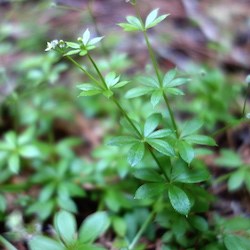
NPS Photo Bedstraw, FragrantGalium triflorum Spreading to form loose mats, this plant has stems about 20 inches (50 cm) long interspersed with whorls of six leaves. Three white-greenish flowers on short stalks branch from the leaf-worls, becoming nutlets (seeds) with hooked hairs that stick to clothes of passing hikers. The leaves release sweet-smelling coumarins when crushed, giving the plant its name. 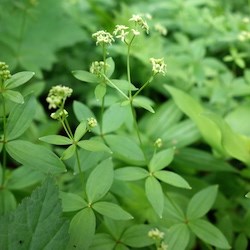
NPS Photo Bedstraw, OregonGalium oreganum This plant has numerous stems, 4-12 inches (10-30 cm) long, branching from creeping rootstock. Unlike fragrant bedstraw which has 6-leaf whorls, Oregon bedstraw has only four leaves per whorl. White-greenish flowers cluster at the end of the stems, and turn into nutlets covered in long, hooked hairs. Common in forests up to 5,000 feet (1,500 m). 
NPS Photo False HelleboreVeratrum viride Also known as corn lily for its large veined leaves that look like corn leaves. Even before the plant blooms, the clusters of leaves can create attractive textures in contrast to other meadow plants. Flowers are green to yellowish-white and bloom in drooping clusters along a tall stem, which can be 12-35 inches (30-88 cm) high. Common in subalpine meadows. 
NPS Photo FleeceflowerPolygonum newberryi One of the first plants to colonize disturbed soil (such as along trails), this plant has brittle stems that can break off and take root where they fall. Stems can be 12 inches (30 cm) long, with pale green oval leaves that turn red in fall. Flowers are small, only 0.1 inch (3 mm) long, and greenish-white in color. Common in drier meadows on the east side of the park, between 6,000-7,500 feet (1,828-2,286 m). 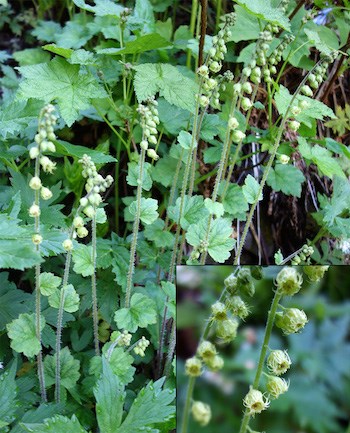
NPS Photo Fragrant FringecupTellima grandiflora 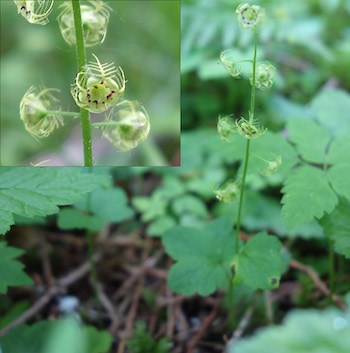
NPS Photo Mitrewort, LeafyMitella caulescens 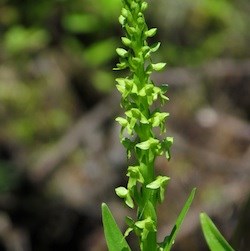
NPS, Crow Vecchio Slender Bog OrchidPlatanthera stricta The flowers of this orchid are green, which can make it difficult to spot amidst the park's lush lowland vegetation. Flowers form a loosely-arranged spike at the top of a 8-24 inch (20-60 cm) tall stem, with alternating lance-shaped leaves along stem. Usually found in wet meadows along streams and springs in both forest to subalpine elevations. 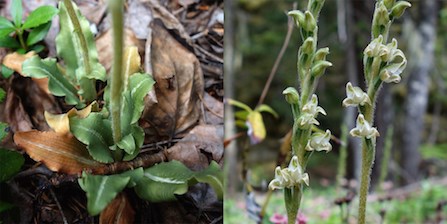
NPS Photo Rattlesnake-PlantainGoodyera oblongifolia Common in drier forests below 4,500 feet (1,371 m), this plant has a ring of basal leaves. Leaves are dark green, with a white stripe mid-rib or mottled white net-like patterns. A single stalk supports many small, hooded greenish-white flowers. 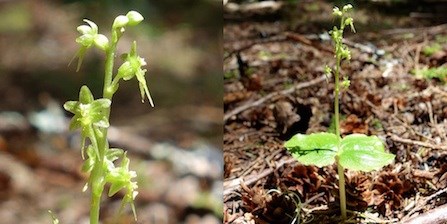
NPS Photo Twayblade, Heart-leafNeottia cordata A member of the orchid family, this plant is named for its two heart-shaped leaves. Flowers are mostly green, but can also be reddish to reddish-brown. Twayblade can be found growing in moist coniferous forest up to 4,500 feet (1,372 m). 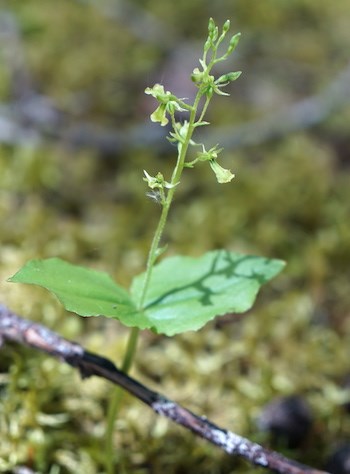
NPS Photo Twayblade, NorthwesternNeottia banksiana Return to Wildflower Guide |
Last updated: March 26, 2025
